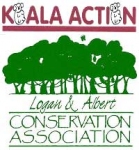"Under the Koala Conservation Plan, the areas with the highest level of protection are Koala Conservation Areas, but these areas must be surveyed and mapped. Without koala mapping, no serious protection is given to koalas," reported LACA spokesperson Anne Page.
"There has already been a huge fragmentation of habitat with the upgrade of the Mt Lindesay Highway from 2 lanes to 10 lanes .As no official koala surveys have been undertaken, Main Roads continues to refuse to fund koala fencing or reduce road speeds along the complete length of the upgraded sections of the Mt Lindesay Highway. Main Roads has also refused to consider fauna crossings other than at Jerry's Downfall and Norris Creek. Community sightings of koalas were collected by LACA in 2007 and environmental consultant reports confirm koalas in the vicinity of Jerry's Downfall and along other sections of the Mt Lindesay Highway."
Other areas where local koala populations occur include Logan Village, Chambers Flat, Park Ridge, Park Ridge South, Munruben, Greenbank, New Beith, Flagstone, North Maclean, Tamborine, Mundoolun, Jimboomba, Stockleigh, Yarrabilba, Buccan, Veresdale Scrub, Cedar Vale, Canungra, Palen Creek, Mt Barney, Rathdowney, Cedar Creek, Wolffdene, Beaudesert, and Bromelton.
The Mt Lindesay Highway is only one example of a current major infrastructure project that will have huge detrimental impacts on regional and local koala populations. With other koala populations in South-east Queensland on decline, this makes any koala and all koala habitat critical for protection - a contradiction under the proposed South-east Queensland Regional Plan (SEQRP).
"The state government reports that the SEQRP will protect 80% of South-east Queensland. This statistic is a fallacy. What if fails to point out to the community, is that much of that 80% is already cleared and fragmented by other land uses and infrastructure like road and rail corridors. Much of this 80% is also subject to old and current development applications which means that there is a mushrooming of developments and habitat clearing now and in the future, even in land areas outside of the urban footprint."
The greatest threat to koalas in South-east Queensland is habitat loss and cars. Measures like fauna friendly backyard designs and fencing will never be able to compensate for the massive habitat clearing that has occurred in South-east Queensland and that has been sanctioned by the State government as "urban footprint" in the South-east Queensland Regional Plan or by the inappropriate development approvals that allow any remaining koala habitat to be cleared and developed. Major infrastructure that does not include fauna sensitive design features from the outset of their design are not best practice, and will not protect koalas from local and regional extinction.
Anna Bligh's government has already stood by and watched the koala population of South-east Queensland dwindle and the state government continues to promote more development part of the SEQRP. A top level task force comprising scientific experts, conservation groups, developers, state government , and local councils will be ineffective if the state government refuses to implement recommended guidelines and policies, and refuses to make adequate financial and other resources available.
At a time when climate change and global warming has received unprecedented media and scientific comment, it is crazy to think that koalas can be protected from extinction in South-east Queensland if the state government and developers are allowed to continue with a business as usual approach.
The Logan and Albert conservation Association awaits the Federal Government's review of its koala strategy and hopes that it will raise the level of protection to be given to koalas in South-east Queensland. Some populations of koalas in South-east Queensland are genetically different to other populations which makes it even more important to save them and their habitat. LACA agrees with the statements made last week by the Australian Koala Foundation and Wildlife Preservation Society of Queensland , that the state government needs to address the issue of koala habitat protection.
Greater investment in green infrastructure (e.g. fauna overpasses, green infrastructure charging ) is urgently needed and regional open space needs to be designated in the South East Queensland Regional Plan.
This plan will be reviewed and available for community consulation and comments towards the end of 2008. If you care about the fate of koalas and other fauna, this will be an opportunity for your input.

